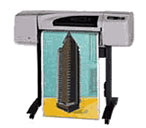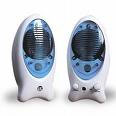Output devices
The computer uses output devices to transfer information to the environment and the user. This includes display screens, printers, plotters, and Disk etc..
Output devices used to output information to users or other machines
Monitors
Monitors are the primary output device of a computer system. Monitors provide us with a graphical representation of information on the screen
There are two types of commonly use monitors.
~ CRT monitors
~ Flat-Panel
CRT (Cathode Ray Tube)
 CRT monitors use cathode ray tube technolog.The same technology use in television sets.
CRT monitors use cathode ray tube technolog.The same technology use in television sets.
The monitor tube is a glass vacuum tube with one end having an electro gun and the other a display surface coated with phosphors
The three electron beams are intended to glow the red, green and blue phosphors.
The CRT monitors use high voltages to create electron beams and this requires a large amount of electricity.
 CRT monitors use cathode ray tube technolog.The same technology use in television sets.
CRT monitors use cathode ray tube technolog.The same technology use in television sets. The monitor tube is a glass vacuum tube with one end having an electro gun and the other a display surface coated with phosphors
The three electron beams are intended to glow the red, green and blue phosphors.
The CRT monitors use high voltages to create electron beams and this requires a large amount of electricity.
Flat-Panel
 The most common type of Flat-Panel monitors is the Liquid Crystal Display (LCD).
The most common type of Flat-Panel monitors is the Liquid Crystal Display (LCD).Earlier it was used in digital calculators and wrist watches etc.Then used in the screens of laptop.
When the technology was introduced it worked in monochrome. But now it supports a full spectrum of colors.
The advantages of the LCD over the CRT are, Flat screen consumes very little space and Better color quality
 By using a printer we can get a hard copy output. The outputs provide by the other devices are not tangible. But printer provides tangible outputs. The four types of printers are;
By using a printer we can get a hard copy output. The outputs provide by the other devices are not tangible. But printer provides tangible outputs. The four types of printers are;
- Ink-jet – sprays droplets of ink on paper. Its good for color printing and provides a very good quality.
- Laser – uses a technology like in photocopiers. Lasers print high quality text and graphics.
- Dot matrix- forms text and graphic images with a matrix of pins.
- Thermal- Heat elements produce images on special heat sensitive paper. Expensive.
Plotter  Plotters are mostly used to print large images. These are mostly used in,
Plotters are mostly used to print large images. These are mostly used in,
~Aided Design (CAD) Drawings
~Construction Plans
~Engineering Drawings
These drawings sometimes come in larger sizes. Then it is not possible to use conventional printer.
Sound Systems
 The sound card and speakers have become a standard component in a computer system.
The sound card and speakers have become a standard component in a computer system.
During the playback sound card converts the digital audio data into an analog form.
In the recording analog signals converted into digital data and stores.
Using MIDI connectors can be directly connected most electronic musical instruments to sound cards.
The sound system started off by having one or two speakers then developed to have one sub-woofer and two or seven speakers
 The sound card and speakers have become a standard component in a computer system.
The sound card and speakers have become a standard component in a computer system.During the playback sound card converts the digital audio data into an analog form.
In the recording analog signals converted into digital data and stores.
Using MIDI connectors can be directly connected most electronic musical instruments to sound cards.
The sound system started off by having one or two speakers then developed to have one sub-woofer and two or seven speakers
Punched card machines
 Prior to the actual period of computers the automatic data processing was handled mainly by punched card machines. A punched card is a card made of special cardboard designed for punched cards. The size of the card is 82 * 186 millimeters
Prior to the actual period of computers the automatic data processing was handled mainly by punched card machines. A punched card is a card made of special cardboard designed for punched cards. The size of the card is 82 * 186 millimeters The card has 12 lines and 80 columns. The card can be perforated with rectangled holes by special devices. It was also possible to save and handle alphabetical information and special characters on punched cards. For this purpose lines 11 and 12 on top of the card were used. Each alphabetic letter or special character was corresponded by a double perforation at the same column e.g. 12,1 = A.
Horizontally the card could be separated to information fields that could be handled (sum up, copy, sort, print) by punched card machines.
 ශිල්ප 64
ශිල්ප 64